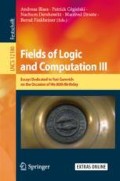Abstract
The First-Order Monadic Logic of Order (\(\textit{FO}[<] \)) is a prominent logic for the specification of properties of systems evolving in time. The celebrated result of Kamp [14] states that a temporal logic with just two modalities Until and Since has the same expressive power as \(\textit{FO}[<] \) over the standard discrete time of naturals and continuous time of reals. An influential consequence of Kamp’s theorem is that this temporal logic has emerged as the canonical Linear Time Temporal Logic (\( LTL )\). Neither \( LTL \) nor \(\textit{FO}[<] \) can express over the reals properties like P holds exactly after one unit of time. Such local metric properties are easily expressible in \(\textit{FO}[<,+1] \) - the extension of \(\textit{FO}[<] \) by +1 function. Hirshfeld and Rabinovich [10] proved that no temporal logic with a finite set of modalities has the same expressive power as \(\textit{FO}[<,+1] \).
\(\textit{FO}[<,+1] \) lacks expressive power to specify a natural global metric property “the current moment is an integer.” Surprisingly, we show that the extension of \(\textit{FO}[<,+1] \) by a monadic predicate “x is an integer” is equivalent to a temporal logic with a finite set of modalities.
Access this chapter
Tax calculation will be finalised at checkout
Purchases are for personal use only
Notes
- 1.
For the sake of simplicity these propositions were stated for \(\mathcal {L}:= LTL \). However, their proofs are sound for any \(\mathcal {L} \succeq _{ exp } LTL \).
- 2.
Formally, \(\textit{FO}[<,+1] \) over bounded intervals uses a binary relation “x at distance one from y” instead of \(+1\) function.
References
Alur, R., Feder, T., Henzinger, T.A.: The benefits of relaxing punctuality. JACM 43(1), 116–146 (1996)
Alur, R., Henzinger, T.A.: Logics and models of real time: a survey. In: de Bakker, J.W., Huizing, C., de Roever, W.P., Rozenberg, G. (eds.) REX 1991. LNCS, vol. 600, pp. 74–106. Springer, Heidelberg (1992). https://doi.org/10.1007/BFb0031988
Barringer, H., Kuiper, R., Pnueli, A.: A really abstract concurrent model and its temporal logic. In: Proceedings of the 13th Annual Symposium on Principles of Programing Languages, pp. 173–183 (1986)
Burgess, J.P., Gurevich, Y.: The decision problem for linear temporal logic. Notre Dame J. Formal logic 26(2), 115–128 (1985)
Gabbay, D., Hodkinson, I., Reynolds, M.: Temporal Logic: Mathematical Foundations and Computational Aspects. Oxford University Press, Oxford (1994)
Gabbay, D., Pnueli, A., Shelah, S., Stavi, J.: On the temporal analysis of fairness. In: POPL 1980, pp. 163–173 (1980)
Henzinger, T.A.: It’s about time: real-time logics reviewed. In: Sangiorgi, D., de Simone, R. (eds.) CONCUR 1998. LNCS, vol. 1466, pp. 439–454. Springer, Heidelberg (1998). https://doi.org/10.1007/BFb0055640
Henzinger, T.A., Raskin, J.-F., Schobbens, P.-Y.: The regular real-time languages. In: Larsen, K.G., Skyum, S., Winskel, G. (eds.) ICALP 1998. LNCS, vol. 1443, pp. 580–591. Springer, Heidelberg (1998). https://doi.org/10.1007/BFb0055086
Hirshfeld, Y., Rabinovich, A.: Logics for real time: decidability and complexity. Fundam. Inform. 62(1), 1–28 (2004)
Hirshfeld, Y., Rabinovich, A.: Expressiveness of metric modalities for continuous time. Logical Methods Comput. Sci. 3(1) (2007)
Hirshfeld, Y., Rabinovich, A.: Decidable metric logics. Inf. Comput. 206(12), 1425–1442 (2008)
Hunter, P.: When is metric temporal logic expressively complete? In: CSL 2013, pp. 380–394 (2013)
Hunter, P., Ouaknine, J., Worrell, J.: Expressive completeness for metric temporal logic. In: LICS 2013, pp. 349–357 (2013)
Kamp, H.: Tense logic and the theory of linear order. Ph.D. thesis, University of California, Los Angeles (1968)
Koymans, R.: Specifying real-time properties with metric temporal logic. Real-Time Syst. 2(4), 255–299 (1990)
Manna, Z., Pnueli, A.: Models for reactivity. Acta informatica 30, 609–678 (1993)
Ouaknine, J., Rabinovich, A., Worrell, J.: Time-bounded verification. In: Bravetti, M., Zavattaro, G. (eds.) CONCUR 2009. LNCS, vol. 5710, pp. 496–510. Springer, Heidelberg (2009). https://doi.org/10.1007/978-3-642-04081-8_33
Pnueli, A.: The temporal logic of programs. In: Proceedings of IEEE 18th Annual Symposium on Foundations of Computer Science, New York, pp. 46–57 (1977)
Rabinovich, A.: Complexity of metric temporal logics with counting and the Pnueli modalities. Theor. Comput. Sci. 411(22–24), 2331–2342 (2010)
Rabinovich, A.: A proof of Kamp’s theorem. Logical Methods Comput. Sci. 10(1) (2014)
Wilke, T.: Specifying timed state sequences in powerful decidable logics and timed automata. In: Langmaack, H., de Roever, W.-P., Vytopil, J. (eds.) FTRTFT 1994. LNCS, vol. 863, pp. 694–715. Springer, Heidelberg (1994). https://doi.org/10.1007/3-540-58468-4_191
Acknowledgment
I would like to thank an anonymous referee for the insightful comments about related works.
Author information
Authors and Affiliations
Corresponding author
Editor information
Editors and Affiliations
Rights and permissions
Copyright information
© 2020 Springer Nature Switzerland AG
About this paper
Cite this paper
Rabinovich, A. (2020). The Expressive Power of Temporal and First-Order Metric Logics. In: Blass, A., Cégielski, P., Dershowitz, N., Droste, M., Finkbeiner, B. (eds) Fields of Logic and Computation III. Lecture Notes in Computer Science(), vol 12180. Springer, Cham. https://doi.org/10.1007/978-3-030-48006-6_16
Download citation
DOI: https://doi.org/10.1007/978-3-030-48006-6_16
Published:
Publisher Name: Springer, Cham
Print ISBN: 978-3-030-48005-9
Online ISBN: 978-3-030-48006-6
eBook Packages: Computer ScienceComputer Science (R0)

